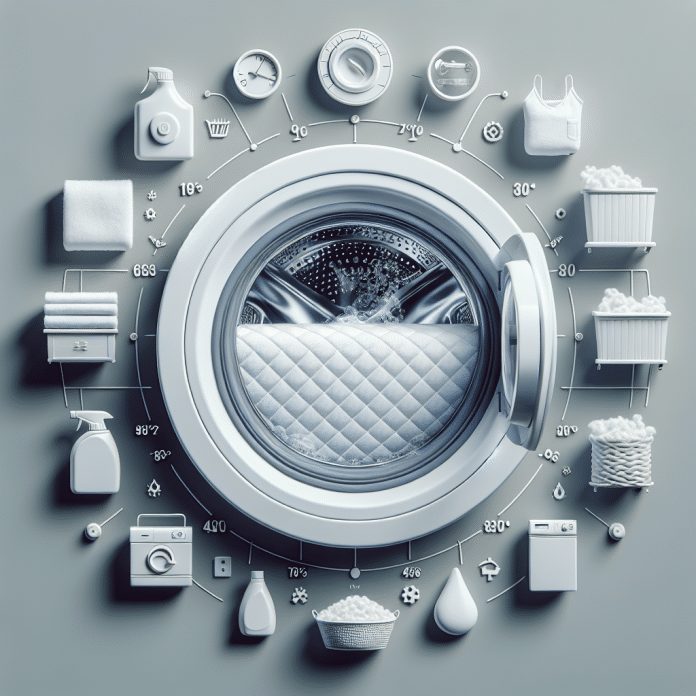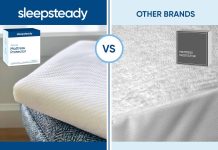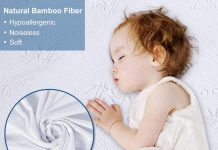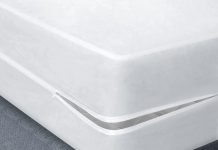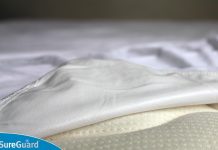Cleaning your mattress protector is an essential part of maintaining a clean and hygienic sleep environment. But with so many different fabrics and materials available, knowing the right temperature for washing can be a bit confusing. Fear not! In this article, we will guide you through the process and reveal the optimal temperature to wash your mattress protectors. So say goodbye to stains, odors, and allergens, and get ready to enjoy a fresh and cozy night’s sleep.
Review contents
Choosing the Right Temperature for Washing Mattress Protectors
When it comes to washing mattress protectors, it’s essential to consider the appropriate temperature for cleaning. The temperature chosen can significantly impact the effectiveness of the wash, as well as the overall lifespan and condition of the protector itself. In this article, we will explore various factors to consider when determining the ideal washing temperature for your mattress protector. We will delve into manufacturer’s instructions, the material of the protector, the presence of stains or odors, allergen and dust mite control, the benefits of high and low-temperature washes, the importance of balancing temperature and care instructions, precautions to take before washing, recommended temperatures for different materials, and conclude with some helpful tips for washing mattress protectors.
Considering the Manufacturer’s Instructions
Before diving into the temperature selection, it is crucial to consult the manufacturer’s instructions for washing your specific mattress protector. The care label or tag attached to the protector typically provides essential guidelines to ensure proper cleaning and maintenance. Following these recommendations will not only keep your mattress protector in optimal condition but also help avoid any potential damage that could void the warranty.
Reading the Care Label
Start by carefully examining the care label attached to your mattress protector. Look for any specific temperature guidelines stated by the manufacturer. The label may indicate a range of temperatures that are considered safe for washing, providing vital information for your cleaning process.
Following the Recommended Guidelines
Manufacturers often conduct extensive research and testing to determine the best washing practices for their products. Therefore, it is generally wise to follow the recommended guidelines provided. These guidelines may include temperature ranges, specific laundry detergents to use, and any additional precautions to be aware of while washing.
Seeking Additional Information
If the care label does not explicitly state the recommended temperature or if you have any doubts, it is advisable to reach out to the manufacturer for clarification. They can provide specific instructions tailored to your mattress protector, ensuring you are cleaning it in the best possible way.
Determining the Material of the Mattress Protector
The material of your mattress protector also plays a significant role in deciding the appropriate washing temperature. Different materials have varying temperature sensitivities, and using the wrong temperature could lead to damage or reduced effectiveness.
Cotton Mattress Protectors
Cotton is a popular material used in mattress protectors due to its breathability and comfort. In most cases, cotton protectors can be safely washed at temperatures ranging from 30°C to 60°C (86°F to 140°F). However, it is crucial to follow the manufacturer’s instructions to ensure the protection and integrity of the cotton fabric.
Polyester or Synthetic Mattress Protectors
Polyester or synthetic mattress protectors are known for their durability and resistance to shrinkage. These materials can generally withstand higher washing temperatures, typically ranging from 40°C to 70°C (104°F to 158°F). However, it is essential to confirm the specific temperature recommendations provided by the manufacturer to avoid unintentional damage.
Waterproof or Vinyl Mattress Protectors
Waterproof or vinyl mattress protectors often require special care due to their unique properties. These protectors are designed to repel liquids and prevent stains from reaching the mattress. Washing at higher temperatures may compromise the waterproof capabilities of these protectors. Therefore, it is generally recommended to wash waterproof or vinyl protectors at lower temperatures, usually between 30°C to 40°C (86°F to 104°F).
Wool or Wool Blend Mattress Protectors
Wool or wool blend mattress protectors are known for their natural insulation and moisture-wicking properties. Due to the delicate nature of wool, it is essential to wash these protectors at lower temperatures, usually around 30°C (86°F). Higher temperatures can cause shrinkage and damage the wool fibers.
Other Material Types
It is essential to research and adhere to the manufacturer’s instructions for any other material types not mentioned above. Each material may have its unique temperature requirements, ensuring proper cleaning and maintenance.
Checking for Stain or Odor
Before choosing the washing temperature, it is vital to assess the condition of the mattress protector for any visible stains or unpleasant odors. Addressing these stains and odors correctly can influence the effectiveness of the wash.
Pre-Treating Stains
If you notice stains on your mattress protector, it is advisable to pre-treat them before washing. Pre-treating involves applying a stain remover or detergent directly to the stain, allowing it to penetrate and break down the stain’s particles. While some stains may require specific treatment, such as enzymatic cleaners for protein-based stains, following the general pre-treating guidelines provided by the manufacturer will help ensure the best results.
Using Enzyme-based Cleaners for Odor Removal
If your mattress protector has an unpleasant odor, using enzyme-based cleaners can be highly effective. These cleaners work by breaking down the organic compounds causing the odor, leaving your protector fresh and odor-free. However, it is crucial to read the manufacturer’s instructions and choose a suitable cleaner to avoid damaging the protector.
Considering Stain and Odor-Specific Instructions
For specific stains or odors, the manufacturer may provide tailored instructions to address those issues properly. These instructions could include recommended temperatures or specific cleaning agents to use. Be sure to follow these instructions closely to achieve optimal results.
Considering Allergen and Dust Mite Control
Allergens and dust mites are common concerns for many individuals, especially those with allergies or asthma. Proper washing techniques can significantly contribute to controlling these allergens and removing dust mites from your mattress protector.
Importance of High Temperature Wash for Allergen Control
Washing your mattress protector at higher temperatures, generally above 60°C (140°F), can effectively eliminate allergens such as pollen, dust mites, and pet dander. The heat helps to break down and remove these allergens, providing a cleaner and more hypoallergenic sleeping environment.
Using Hypoallergenic Detergents
Choosing hypoallergenic detergents can further enhance the allergy control of your mattress protector. These detergents are specially formulated to be gentle on the skin and minimize the risk of triggering allergic reactions. When used in combination with high-temperature washes, hypoallergenic detergents can help alleviate allergy symptoms and create a more comfortable sleeping experience.
Using Hot Water or Steam for Dust Mite Removal
Dust mites are a common trigger for allergies and respiratory issues. To effectively eliminate dust mites from your mattress protector, washing at higher temperatures or utilizing steam can be particularly effective. Hot water and steam can penetrate the fabric, killing dust mites and removing their allergenic waste.
Benefits of Washing at High Temperatures
Washing mattress protectors at higher temperatures can offer several benefits that contribute to a cleaner and healthier sleeping environment.
Effective Germ and Bacteria Removal
Higher temperatures, typically above 60°C (140°F), are known to effectively kill germs and bacteria. By washing your mattress protector at these temperatures, you can ensure the removal and destruction of any harmful microbes present on the protector’s surface. This can be especially beneficial for individuals with compromised immune systems or those who are prone to infections.
Improved Allergen Control
As previously mentioned, high-temperature washes can effectively eliminate allergens such as pollen, dust mites, and pet dander. By removing these allergens from your mattress protector, you can reduce the risk of allergic reactions and create a more comfortable sleeping environment for individuals with allergies or asthma.
Better Stain Removal
Higher temperatures generally improve the effectiveness of stain removal on mattress protectors. Hot water can dissolve and break down stains, making it easier for detergents to penetrate and remove them from the fabric. This is particularly advantageous for stubborn stains that may not be thoroughly eliminated with lower temperature washes.
Elimination of Dust Mites
Dust mite infestations can be a common concern for individuals with allergies or asthma. Washing your mattress protector at high temperatures can effectively eliminate dust mites present on the surface, reducing the risk of allergic reactions and improving overall sleep quality.
Benefits of Washing at Low Temperatures
While high-temperature washes offer several advantages, washing mattress protectors at lower temperatures also has its benefits.
Preservation of Mattress Protector Integrity
Some mattress protectors, particularly those made of delicate materials such as wool or certain synthetics, may be prone to shrinkage or damage when exposed to high temperatures. By opting for lower temperature washes, you can preserve the integrity of these protectors and ensure their longevity.
Energy and Cost Savings
Washing at lower temperatures generally requires less energy to heat the water, resulting in energy and cost savings. If your mattress protector does not contain stubborn stains or requires high-temperature washing due to specific circumstances, choosing a lower temperature can be an eco-friendly option.
Gentler on Delicate Materials
Certain materials, such as wool or silk, may require gentle care to maintain their softness and integrity. Washing these delicate mattress protectors at lower temperatures can help prevent damage, shrinkage, or distortion of the fabric, ensuring their durability and functionality.
Importance of Balancing Temperature and Care Instructions
It is essential to strike a balance between the desired washing temperature and the care instructions provided by the manufacturer. Taking into account the maximum temperature allowed by the manufacturer and any specific guidelines mentioned will help avoid damage to the mattress protector and ensure that it remains in optimal condition.
Considering the Maximum Temperature Allowed
While high-temperature washes can provide numerous benefits, it is crucial to confirm the maximum temperature allowed by the manufacturer. Exceeding this temperature could result in shrinkage, damage to the fabric, or loss of effectiveness in protecting your mattress.
Avoiding Excessive Heat
Regardless of the temperature selected, it is essential to avoid the excessive heat settings on your washing machine or dryer. Excess heat could potentially warp, melt, or damage the mattress protector, compromising its quality and functionality.
Taking into Account Individual Circumstances
Individual circumstances, such as the severity of stains, presence of odors, or specific allergen concerns, may require adjustments to the washing temperature. If you find yourself dealing with a particularly stubborn stain or an excessive dust mite infestation, consulting with professionals or seeking tailored advice from the manufacturer may be beneficial in determining the appropriate temperature.
Precautions to Take Before Washing
Before proceeding with washing your mattress protector, it is crucial to take some precautions to ensure the best results and avoid any potential damage.
Removing the Mattress Protector Properly
Carefully remove the mattress protector from the bed, taking care not to stretch or tear the fabric. Gently lift the corners and edges to prevent any unnecessary stress on the protector, especially if it is snugly fitted onto the mattress.
Checking for Any Visible Damage
Inspect the mattress protector for any visible signs of damage, such as holes, tears, or loose threads. Address these issues before washing, as washing damaged or compromised protectors could worsen the damage or affect their functionality.
Addressing Specific Care Instructions
Take note of any specific care instructions provided by the manufacturer. These instructions may include recommendations for separating colors, avoiding certain cleaning agents, or utilizing particular wash cycles. Following these instructions will help ensure the best outcome for your mattress protector.
Recommended Temperatures for Different Mattress Protector Materials
While specific temperature recommendations may vary depending on the manufacturer, here are some general guidelines for washing different mattress protector materials:
- Cotton mattress protectors: 30°C to 60°C (86°F to 140°F)
- Polyester or synthetic mattress protectors: 40°C to 70°C (104°F to 158°F)
- Waterproof or vinyl mattress protectors: 30°C to 40°C (86°F to 104°F)
- Wool or wool blend mattress protectors: Around 30°C (86°F)
- Other material types: Follow the manufacturer’s instructions
It is important to note that these temperature ranges are general guidelines, and it is crucial to refer to the care label or manufacturer’s instructions for accurate and specific temperature recommendations.
Tips for Washing Mattress Protectors
To ensure the best results and maintain the longevity of your mattress protector, here are some helpful tips to follow:
Using Mild Detergents
Opt for mild, hypoallergenic detergents specifically formulated for sensitive skin. These detergents are gentler on the fabric and reduce the risk of skin irritation or allergic reactions.
Avoiding Bleach or Harsh Chemicals
Avoid using bleach or harsh chemical cleaners on your mattress protector, especially if not recommended by the manufacturer. These chemicals can damage the fabric and compromise the protector’s protective qualities.
Preferably Air Drying
Whenever possible, air drying is the preferred method for drying mattress protectors. Hanging the protector in a well-ventilated area, away from direct sunlight, helps preserve the fabric’s integrity and prevent shrinking.
Using Low Heat on Dryers if Required
If using a dryer, choose a low heat setting to prevent excessive heat exposure. High temperatures in dryers can cause shrinking or distortion of the fabric. Follow the manufacturer’s instructions regarding the appropriateness of using a dryer for your specific mattress protector.
By following these tips and guidelines, you can effectively clean and maintain your mattress protector, ensuring both its longevity and functionality.
In conclusion, choosing the right temperature for washing your mattress protector is essential for maintaining its condition and effectiveness. By considering the manufacturer’s instructions, determining the material of the protector, checking for stains or odors, considering allergen and dust mite control, understanding the benefits of high and low-temperature washes, balancing temperature and care instructions, taking necessary precautions, and following recommended temperature ranges for different materials, you can successfully wash your mattress protector while ensuring its cleanliness and longevity.

